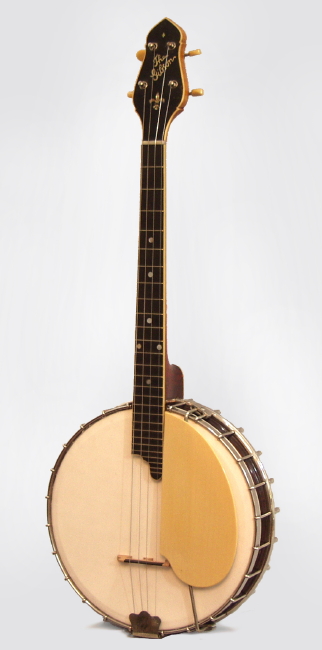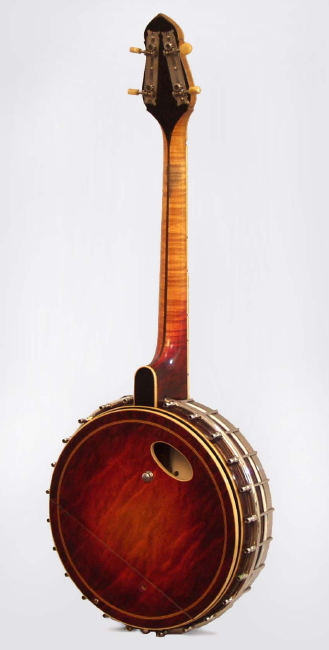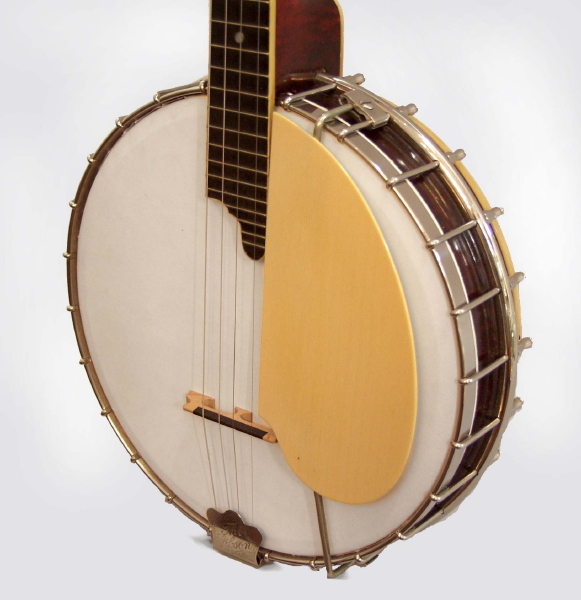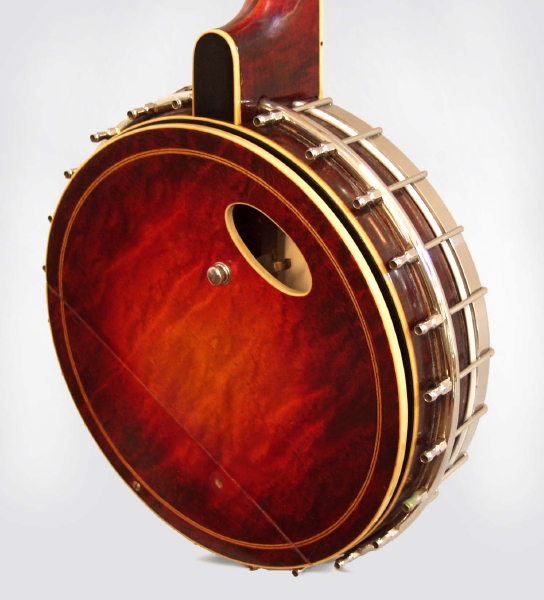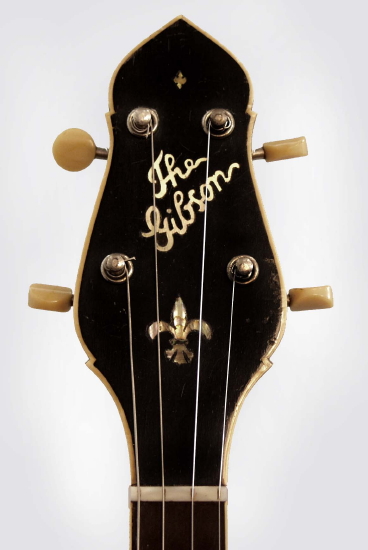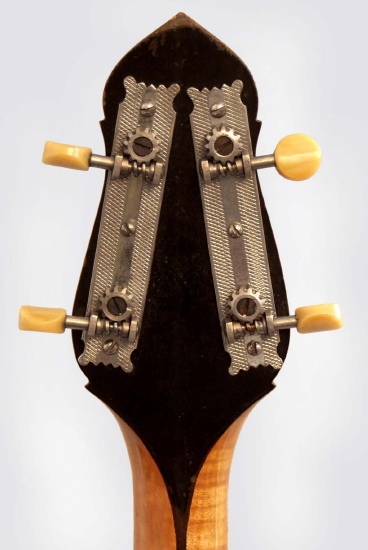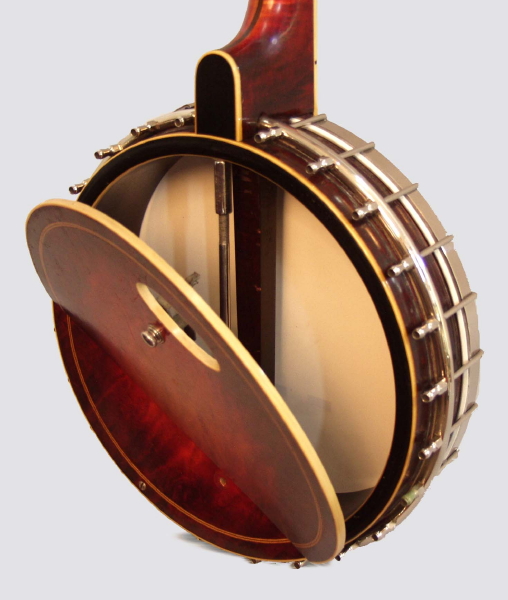Gibson TB-4 Tenor Banjo , c. 1922
This item has been sold.
Item # 3597
Prices subject to change without notice.
Gibson TB-4 Model Tenor Banjo, c. 1922, made in Kalamazoo, Michigan, red sunburst varnish finish, laminated maple neck and rim, original black hard shell case.
The Gibson TB-4 banjo from this era is a lovely instrument, though not the banjo design the company would be remembered for. These early Gibson banjos have the feel of having been designed by and for mandolin player -- as indeed they were. While never particularly popular among most tenor banjo players, they are beautifully built instruments with an attractive Nouveau aesthetic all their own.
The narrow short scale neck is a 3-way maple/ebony laminate with a dot-inlaid extended ebony fingerboard bound in grained ivoroid. The single-bound "moccasin" headstock is veneered with ebony and inlaid with a slanted "The Gibson" logo and slotted diamond and fleur-de-lys designs. The heel, rim, and "trap door" resonator are ivoroid bound. The trapdoor also has a ring of inlaid wood and an ivoroid bound "peephole" and is finished in a striking cherry sunburst.
The bound heel is also sunburst and the back of the head is black with a point faired into the neck's ebony stripe. The tuners are nickel two-on-a-plate with amber celluloid buttons. The nut is pearl, characteristic of top-line Gibsons of this era. The rim is cherry-stained maple capped with ebony. The tube hook/nut bearing used on this banjo would become half of the "tube and plate" flange system when the "plate" flange was added. This banjo is one of the earliest to feature a single co-coordinator rod, mounted here below the traditional wooden dowel and marked "Patent Applied for".
The nickel-plated tailpiece cover has "The Gibson" and decorative designs impressed. The flat plate "trap door" resonator can be opened or closed to alter the tone of the banjo; this instrument would have been one of the first to feature this system. Inside the rim is a gold "Gibson Guarantee" label and impressed serial number.
The original green plush-lined shaped case is included. This was an expensive ($150) instrument in its day, equivalent to the F-4 mandolin and L-4 guitar, and indeed was top of the line until the Style 5 Master Model line was introduced. A fine playable piece of 1920's Gibson history for the enthusiast or collector.
Overall length is 29 in. (73.7 cm.), 10 5/8 in. (27 cm.) diameter head, and 3 in. (7.6 cm.) in depth, measured at side of rim. Scale length is 19 in. (483 mm.). Width of nut is 1 3/16 in. (30 mm.).
All original, except missing the internal securing bracket for mounting the trap door to the co-ordinator rod. Minor finish wear, but overall a very nice example. Set up with a newer skin head and bridge. Generally Excellent Condition.
The Gibson TB-4 banjo from this era is a lovely instrument, though not the banjo design the company would be remembered for. These early Gibson banjos have the feel of having been designed by and for mandolin player -- as indeed they were. While never particularly popular among most tenor banjo players, they are beautifully built instruments with an attractive Nouveau aesthetic all their own.
The narrow short scale neck is a 3-way maple/ebony laminate with a dot-inlaid extended ebony fingerboard bound in grained ivoroid. The single-bound "moccasin" headstock is veneered with ebony and inlaid with a slanted "The Gibson" logo and slotted diamond and fleur-de-lys designs. The heel, rim, and "trap door" resonator are ivoroid bound. The trapdoor also has a ring of inlaid wood and an ivoroid bound "peephole" and is finished in a striking cherry sunburst.
The bound heel is also sunburst and the back of the head is black with a point faired into the neck's ebony stripe. The tuners are nickel two-on-a-plate with amber celluloid buttons. The nut is pearl, characteristic of top-line Gibsons of this era. The rim is cherry-stained maple capped with ebony. The tube hook/nut bearing used on this banjo would become half of the "tube and plate" flange system when the "plate" flange was added. This banjo is one of the earliest to feature a single co-coordinator rod, mounted here below the traditional wooden dowel and marked "Patent Applied for".
The nickel-plated tailpiece cover has "The Gibson" and decorative designs impressed. The flat plate "trap door" resonator can be opened or closed to alter the tone of the banjo; this instrument would have been one of the first to feature this system. Inside the rim is a gold "Gibson Guarantee" label and impressed serial number.
The original green plush-lined shaped case is included. This was an expensive ($150) instrument in its day, equivalent to the F-4 mandolin and L-4 guitar, and indeed was top of the line until the Style 5 Master Model line was introduced. A fine playable piece of 1920's Gibson history for the enthusiast or collector.
Overall length is 29 in. (73.7 cm.), 10 5/8 in. (27 cm.) diameter head, and 3 in. (7.6 cm.) in depth, measured at side of rim. Scale length is 19 in. (483 mm.). Width of nut is 1 3/16 in. (30 mm.).
All original, except missing the internal securing bracket for mounting the trap door to the co-ordinator rod. Minor finish wear, but overall a very nice example. Set up with a newer skin head and bridge. Generally Excellent Condition.
